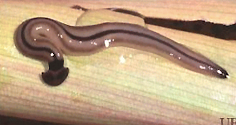When it starts to rain, things start happening. Growers come in with some interesting specimens. Wet, high leaf mulch environments create a special world that brings out some interesting creatures like slime molds and land planaria.
Land planaria are large, ‘slimy,' flatworms that reach ¾-12 ½ inches in length and 1/8 inch wide. Unlike their parasite relatives the tapeworms, these flatworms are free living predators of earthworms, slugs, snails and soil arthropods. Originally brought to the United States in the soil of potted plants transported from Indo-China, land planaria were first found in American greenhouses in 1901. As residents of potted plants, they were transported into new areas, established themselves in green houses, and eventually moved out to adjacent areas. Today land planaria are found in the natural environment of several states including: Alabama, California, Florida, Georgia, Illinois, Kentucky, Louisiana, Massachusetts, Mississippi, New Jersey, New York, North Carolina, Ohio, Oklahoma, South Carolina, Tennessee, and Texas.
Land planaria are brown-gray to yellowish in color with a series of long, dark stripes starting at the head. As a planarian ages the stripes become one long line, reaching the tip of the body. They have a triangular-shaped head and a long flattened body. Some have eyespots. The ‘slimy' appearance of planarians is due to a continual secretion of a mucus-type material. The mucus helps the planarian maintain body moisture, move, and is a defense mechanism due to its horrible taste. Land planaria are able to survive freezing weather conditions by resting in protected areas where boards or fallen trees cover rooted plants. During warmer seasons they are found under logs, rocks, woodpiles, plant debris and occasionally caves, but are rarely found in rural areas. They go where the nursery plants went. Oddly, they are rarely found in mulch-rich avocado orchards because most avocado orchards have few earthworms. Go look. Most avocados came from nurseries where potting mixes were fumigated or pasteurized before being sent out to the field and earthworms didn't go with the trees.
Throughout the fall and winter, planarians move outside their protective areas at night to hunt for earthworms that come to the soil surface after rainstorms subside. They prefer dark areas, cool temperatures and require high humidity. A humid environment is essential because death occurs quickly if a planarian losses 45% of its body moisture.
The inside of a land planaria is quite simple. They do not have a skeleton, circulatory, respiratory or digestive system. The nervous system consists of a mass of nerve tissue in the head attached to longer nerves in the body, arranged in a ladder shape.
Locomotion is made possible by the “creeping sole”; a strip of hairs going down the middle of the underside of the body and mucus secretion glands. The secretion glands deposit a layer of mucus that the hairs push against to move the planarians body across a surface.
Land planaria can reproduce in two ways. When land planarians reproduce by mating, they place eggs in cocoons that are red in color. After 24 hours, the cocoon turns black and the eggs continue to develop. Young planarians hatch and leave the cocoons within 21 days. If a land planaria reproduces without mating, the parent moves across the ground and attaches the tip of its tail to a rock or piece of wood. Once the tail is attached, the flatworm moves forward and the tip of the tail remains on the substrate. The tip of the tail left by the parent develops a head within 10 days and a young planarian is formed. A parent deposits the tip of its tail once or twice a month.
Land planaria primarily consume earthworms and other small soil organisms. They have one opening on the underside of their body that serves for both intake and elimination. The mouth extends and penetrates the body of a prey item when the planarian is attacking. Digestive mucus and the circular muscles within the mouth contract causing a sucking motion that allows the planarian to feed. The victim is slowly reduced into small particles that are consumed. Land planarians can survive for several weeks without food. If little prey is available, they will become cannibalistic or use their own reproductive tissue as a food source.
The only economic problem associated with land planarians is their ability to destroy entire earthworm populations in a greenhouse. Land planarians can disturb property owners who find them and their trails of mucus disgusting or annoying. The number of land planarians in an area usually is small and control is not recommended. In fact, it takes just the right sort of environment to consistently see them, like an irrigated garden with lots of hiding places or an orchard near a garden.
Photo: Univ. of Florida
Attached Images:
